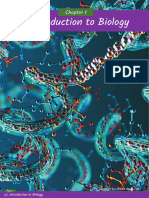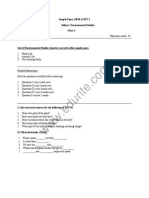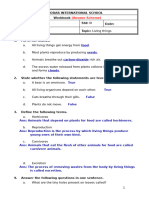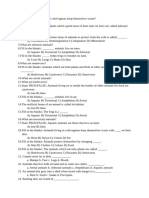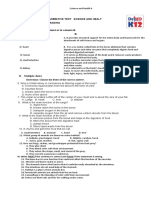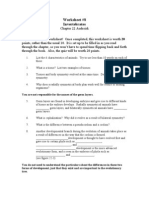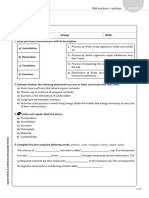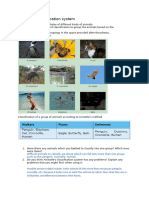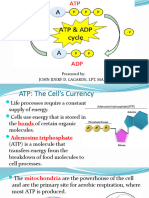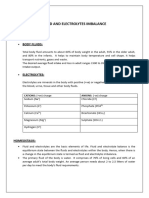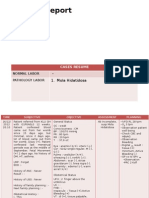Chapter 4 - Living Things: Workbook - Answer Key
Chapter 4 - Living Things: Workbook - Answer Key
Uploaded by
Sonal SuryawanshiCopyright:
Available Formats
Chapter 4 - Living Things: Workbook - Answer Key
Chapter 4 - Living Things: Workbook - Answer Key
Uploaded by
Sonal SuryawanshiOriginal Title
Copyright
Available Formats
Share this document
Did you find this document useful?
Is this content inappropriate?
Copyright:
Available Formats
Chapter 4 - Living Things: Workbook - Answer Key
Chapter 4 - Living Things: Workbook - Answer Key
Uploaded by
Sonal SuryawanshiCopyright:
Available Formats
Chapter 4 - LIVING THINGS
Workbook - Answer Key
1. Choose the correct option:
a) Fish breathe through.
i) tiny holes on the body
ii) gills
iii) nose
iv) stomata
b) The process in which living things produce young ones of their own
kind is called____________.
i) respiration
ii) response
iii) reproduction
iv) breathing
2. Give two examples for each of the following:
a) Animals that do not have legs.
Ans. Snakes and earthworms
b) Animals that use their wings to fly and legs to walk.
Ans. Birds and insects
c) Animals that breathe through tiny holes on their body.
Ans. Cockroaches, earthworms and grasshoppers
3. State whether the following statements are true or false:
a) Insects have feelers to sense the environment.
Ans. True
b) Seeds grow into new plants.
Ans. True
4. Answer in one sentence:
a) What are stomata?
Ans. Leaves of plants breathe through tiny pores present on the
underside of the leaves called stomata.
b) How do animals obtain their food?
Ans. Animals obtain their food from plants and other animals.
5. Answer the following questions in 2-3 sentences:
a) State any three characteristics of living things.
Ans. The characteristics of living things are: (you can write all or any
three)
1) Living things grow.
2) Living things breathe
3) Living things move on their own.
4) Living things need food and water
5) Living things feel the changes in their environment.
6) Living things reproduce.
b) How do plants respond to touch? Explain with the help of an
example.
Ans. Plants such as the ‘touch-me-not’ can feel. They close their
leaves when you touch them.
c) Why do animals move from one place to the other?
Ans. Animals move from one place to another in search of food and
shelter. They also move to protect themselves from their enemies.
6. Observe the picture and answer the questions that follow:
a) Identify the above animal.
Ans. Chital Deer (Spotted Deer / Axis Deer)
b) How does this animal reproduce?
Ans. This animal reproduces by giving birth to young ones of its own
kind.
7. Read the paragraph and answer the questions that follow:
Plants do not move from one place to another, but some parts of plant
show movement. The roots of a plant grow and move into the soil in search
of water. The stems of the plant move towards the light. A sunflower turns
in the direction of the sun.
a) In which direction do the roots of a plant grow? Why?
Ans. The roots of a plant grow and move into the soil in search of
water and minerals.
b) Which part of the plant moves towards the light?
Ans. The stems of the plant move towards the light.
8. Join the dots from 1 to 44 to obtain the picture of an animal, colour
it and complete the given statement.
The animal reproduces by giving birth to young ones of its own kind.
9. Higher Order Thinking Skills (HOTS):
A car movement from one place to another. It needs fuel to move. Can we
say that it is a living thing? Justify your answer.
Ans. No, because a car needs fuel to move and it does not move on
its own or shows any growth, neither does it respond to any stimuli
nor can breathe as these are the characteristics of a living thing.
Therefore, it cannot be considered a living thing.
You might also like
- s4 Bio en WorkbookDocument125 pagess4 Bio en WorkbooknatfiverNo ratings yet
- Vanda Science Competitions Primary Grade 3 SampleDocument11 pagesVanda Science Competitions Primary Grade 3 SampleWidada Winata Atmaja100% (5)
- Lesson Plan in Science Grade 1 Unit 1Document9 pagesLesson Plan in Science Grade 1 Unit 1songdalen201395% (21)
- Cbse Class 1 Evs Sample Paper Term 1 Model 2Document2 pagesCbse Class 1 Evs Sample Paper Term 1 Model 2Sunaina Rawat67% (3)
- Anesthesia Final ExamDocument7 pagesAnesthesia Final ExamAmeer El Falastiny86% (7)
- 39740-PDF Notes Grade - 3 Science Lesson 1 Living and Non-Living ThingsDocument14 pages39740-PDF Notes Grade - 3 Science Lesson 1 Living and Non-Living ThingsNishant JasaniNo ratings yet
- 1720020844438.AS - WB - CB - III - EVS - Living ThingsDocument5 pages1720020844438.AS - WB - CB - III - EVS - Living Thingspriti90meshramNo ratings yet
- Science - The Living and The Non-Living Ques & Ans (VI)Document6 pagesScience - The Living and The Non-Living Ques & Ans (VI)kwadwoadusei287No ratings yet
- Evs Unit Test 1Document3 pagesEvs Unit Test 1jint235No ratings yet
- Living Things Part 2 Sc. Class 3Document11 pagesLiving Things Part 2 Sc. Class 3Aditya0% (1)
- CL VI Science First TerminalDocument31 pagesCL VI Science First Terminalsabirafrin100% (1)
- 3 ScienceDocument4 pages3 ScienceRazel Mae Pabellorin BarcialNo ratings yet
- 7th FA1Document24 pages7th FA1mohd iqbal IqbalNo ratings yet
- CBSE Sample Paper For Class 1 EVSDocument7 pagesCBSE Sample Paper For Class 1 EVSVivek K Singh100% (1)
- Spark Science 4 KeybookDocument44 pagesSpark Science 4 Keybookzainabirfan7866100% (1)
- WA EvsDocument10 pagesWA EvsurmeesolapurNo ratings yet
- Biology M17 Animals Without BackbonesDocument40 pagesBiology M17 Animals Without BackboneschobynetNo ratings yet
- Science Mid-Term Solved ExercisesDocument19 pagesScience Mid-Term Solved ExercisesJaveria AzmatNo ratings yet
- AEC All About Plants - Lesson 01Document10 pagesAEC All About Plants - Lesson 01theresaNo ratings yet
- 3 Science L 1Document3 pages3 Science L 1sonujainaku123No ratings yet
- 1 Summative Test Science and HealtDocument5 pages1 Summative Test Science and HealtCarl John PeroteNo ratings yet
- 6th G.Science Unit 3Document3 pages6th G.Science Unit 3Ricky AndersonNo ratings yet
- Biology CellDocument30 pagesBiology CellgemaNo ratings yet
- Worksheet 7 InvertebratesDocument8 pagesWorksheet 7 InvertebratesAbdulla Saleem100% (1)
- Unit Post-Summative TestDocument5 pagesUnit Post-Summative Testapi-301596131No ratings yet
- Chapter 3Document5 pagesChapter 3tanvinamahatazNo ratings yet
- 4th Class ScienceDocument9 pages4th Class ScienceM Saadat SaeediNo ratings yet
- Class 3 Science Chapter 1, 2 & 3Document10 pagesClass 3 Science Chapter 1, 2 & 3eliasadeyemi33No ratings yet
- Tugas B.ing 3 KikiDocument6 pagesTugas B.ing 3 KikiSesar Fikri FirmansyahNo ratings yet
- VertebratesDocument4 pagesVertebratesAntonia Escobar VegaNo ratings yet
- Extra Activities:: Name: Class: Group: DateDocument2 pagesExtra Activities:: Name: Class: Group: DateemiliNo ratings yet
- Science: Choose The Correct OptionDocument2 pagesScience: Choose The Correct Optionazizul hasanNo ratings yet
- Living and Nonliving AnsDocument3 pagesLiving and Nonliving AnsdebrajismynameNo ratings yet
- Living ThingsDocument7 pagesLiving Thingsmaieqa87No ratings yet
- Science 4 Summative TestDocument2 pagesScience 4 Summative TestAngelo SatorreNo ratings yet
- VijayDocument9 pagesVijayADITYA ASHOK YADAVNo ratings yet
- LV 4 As 1 About PlantsDocument5 pagesLV 4 As 1 About PlantstheresaNo ratings yet
- Biology 1ch?Document5 pagesBiology 1ch?harshuvish009No ratings yet
- Class9 Bio DiversityDocument10 pagesClass9 Bio DiversitySathish Rao TulaNo ratings yet
- Plant CellDocument80 pagesPlant CellEsther Suan-LancitaNo ratings yet
- Class 4 Cbse Evs Sample Paper Term 1 Model 2Document2 pagesClass 4 Cbse Evs Sample Paper Term 1 Model 2Sunaina RawatNo ratings yet
- Whole GSC NotesDocument26 pagesWhole GSC Notesnayab saifNo ratings yet
- The Living World WorksheetDocument6 pagesThe Living World WorksheetdikshitaNo ratings yet
- BIOLOGY S1 Question and Marking Scheme(1)Document15 pagesBIOLOGY S1 Question and Marking Scheme(1)Mugabo AlexNo ratings yet
- Worksheet I SolutionDocument7 pagesWorksheet I SolutionMahesh SinghNo ratings yet
- Class XI Biology Notes Chapter 1 The Living WorldDocument26 pagesClass XI Biology Notes Chapter 1 The Living WorldArtham ResourcesNo ratings yet
- SCIENCE 5 - Q2 - Mod3Document24 pagesSCIENCE 5 - Q2 - Mod33tj internet100% (1)
- XDocument2 pagesXguptaharshal939No ratings yet
- Biology IGCSE Solution BookDocument161 pagesBiology IGCSE Solution BookMuhammad BinyameenNo ratings yet
- Grade 7 - Bio - Biodiversity - Worksheet1-AnswersDocument4 pagesGrade 7 - Bio - Biodiversity - Worksheet1-Answerslokapavani_senthilNo ratings yet
- Science March Study GuideDocument4 pagesScience March Study GuideLuis GonzalezNo ratings yet
- Textbook Chap. 1 Characteristics and Classification of Living OrganismsDocument50 pagesTextbook Chap. 1 Characteristics and Classification of Living Organismsnaomaahmad123456789No ratings yet
- The Body and Its MovementsDocument8 pagesThe Body and Its MovementssuyashNo ratings yet
- G6_Q2Document4 pagesG6_Q2MELODY BAYLONNo ratings yet
- Living and Non Living Things - Class NotesDocument3 pagesLiving and Non Living Things - Class NotesKrishnaNo ratings yet
- 5th Class Science NotesDocument4 pages5th Class Science Notesmalikgraphics0No ratings yet
- Informational Passages RC - MosquitoesDocument2 pagesInformational Passages RC - Mosquitoesandreidmannn100% (1)
- 4TH Quarter Exam in ScienceDocument5 pages4TH Quarter Exam in ScienceClaudine ColinayoNo ratings yet
- NCERT Exemplar Class 7 Science Solutions Chapter 1 Nutrition in PlantsDocument10 pagesNCERT Exemplar Class 7 Science Solutions Chapter 1 Nutrition in PlantsSiva PrasadNo ratings yet
- O Level Biology Practice Questions And Answers: Reproduction In PlantsFrom EverandO Level Biology Practice Questions And Answers: Reproduction In PlantsRating: 3 out of 5 stars3/5 (2)
- O Level Biology Practice Questions And Answers: Ecology And Our Impact On The EcosystemFrom EverandO Level Biology Practice Questions And Answers: Ecology And Our Impact On The EcosystemNo ratings yet
- ATP-ADP Cycle PowerpointDocument18 pagesATP-ADP Cycle PowerpointJohn Iderf LagardeNo ratings yet
- Biology Practical Experiment 12,13, 14 & 15Document8 pagesBiology Practical Experiment 12,13, 14 & 15Ruby KumariNo ratings yet
- Catalase Enzyme LabDocument3 pagesCatalase Enzyme LabBruce0% (1)
- Control of Pain in Operative DentistryDocument5 pagesControl of Pain in Operative DentistryAnkit VirdiNo ratings yet
- Fluid and Electrolyte Imbalance PDFDocument21 pagesFluid and Electrolyte Imbalance PDFShafaq AlamNo ratings yet
- ANATOMY AND PHYSIOLOGY SummaryDocument42 pagesANATOMY AND PHYSIOLOGY SummaryBrythym Mojeca De GuzmanNo ratings yet
- General CharacteristicsDocument145 pagesGeneral CharacteristicsMuhammad Akbar SiddiqNo ratings yet
- BIOEN 345: Failure Analysis of Physiology: Lecture 4 May 4, 2020: Vessel PathologiesDocument45 pagesBIOEN 345: Failure Analysis of Physiology: Lecture 4 May 4, 2020: Vessel PathologiesasdfghjklNo ratings yet
- 3-BIOL 101 Study Guide Quiz 3Document8 pages3-BIOL 101 Study Guide Quiz 3Suraj NaikNo ratings yet
- Class 11th Sample Paper 03 Zoology Ankita Mam Puja Soni QuestionsDocument6 pagesClass 11th Sample Paper 03 Zoology Ankita Mam Puja Soni QuestionsMD SAZID ALAMNo ratings yet
- Management of Hyperosmolar Hyperglycaemic StateDocument11 pagesManagement of Hyperosmolar Hyperglycaemic StateTowhidulIslamNo ratings yet
- Assessment Diagnosis Planning Intervention Rationale EvaluationDocument4 pagesAssessment Diagnosis Planning Intervention Rationale EvaluationJhoizel VenusNo ratings yet
- Pharmacology QuestionsDocument12 pagesPharmacology QuestionsNippu RaaNo ratings yet
- Anatomy of RetinaDocument18 pagesAnatomy of RetinaNuman QayyumNo ratings yet
- Module 6 - Prokaryotes and EukaryotesDocument17 pagesModule 6 - Prokaryotes and EukaryotesKimberly CelisNo ratings yet
- Full Veneer Retainers in FPDDocument68 pagesFull Veneer Retainers in FPDSukhjeet KaurNo ratings yet
- CVS NotesDocument13 pagesCVS NotesMind PowerNo ratings yet
- Morning Report AbortusDocument6 pagesMorning Report AbortusmelatiigdNo ratings yet
- Parts of The HeartDocument15 pagesParts of The HeartBobbie LittleNo ratings yet
- Science and TechnologyDocument3 pagesScience and TechnologyKeysiNo ratings yet
- Case Study - Bencar & Duval PharmaDocument6 pagesCase Study - Bencar & Duval PharmaHaleema Bibi0% (1)
- 4. week ovulation, fertilization, implantation (١)Document41 pages4. week ovulation, fertilization, implantation (١)Maisy JohnNo ratings yet
- Osteomalacia Care Plan/OthersDocument11 pagesOsteomalacia Care Plan/OthersJill Jackson, RNNo ratings yet
- Autopsy Report of Phoenix RiverDocument17 pagesAutopsy Report of Phoenix RiverAnn MirNo ratings yet
- LA771 930422 Find Yourself Through Your InsecuritiesDocument6 pagesLA771 930422 Find Yourself Through Your InsecuritiesCaterina MongilloNo ratings yet
- Placenta PreviaDocument6 pagesPlacenta Previamiss RN93% (14)
- HHS Public AccessDocument14 pagesHHS Public AccessFachrul HardtopNo ratings yet
- Plant Cell and Animal Cell - Docx YuvenDocument8 pagesPlant Cell and Animal Cell - Docx YuvenVikneswaran Gunahlan NeshNo ratings yet
